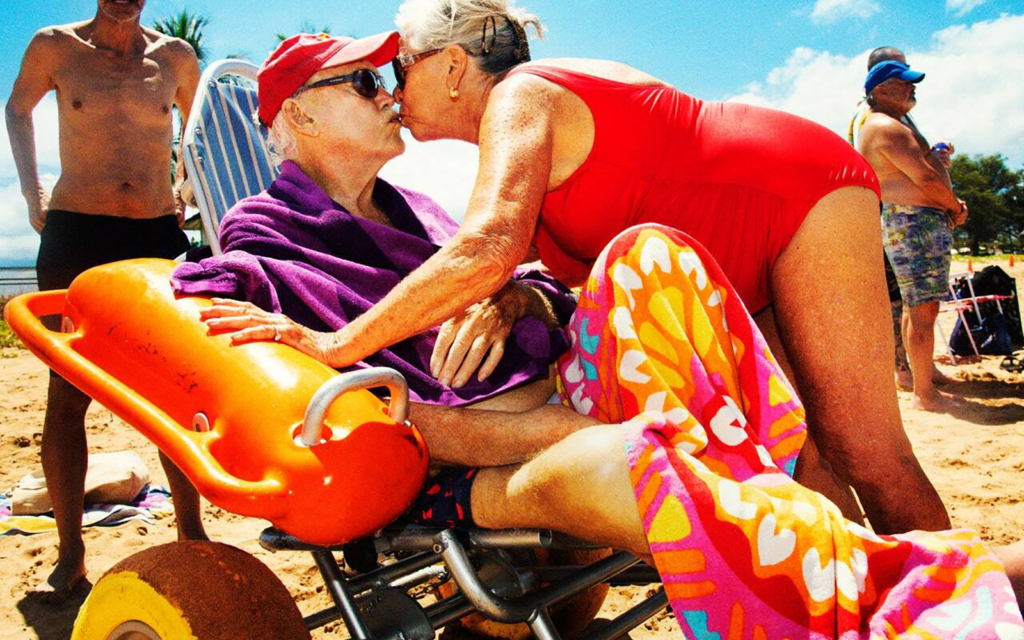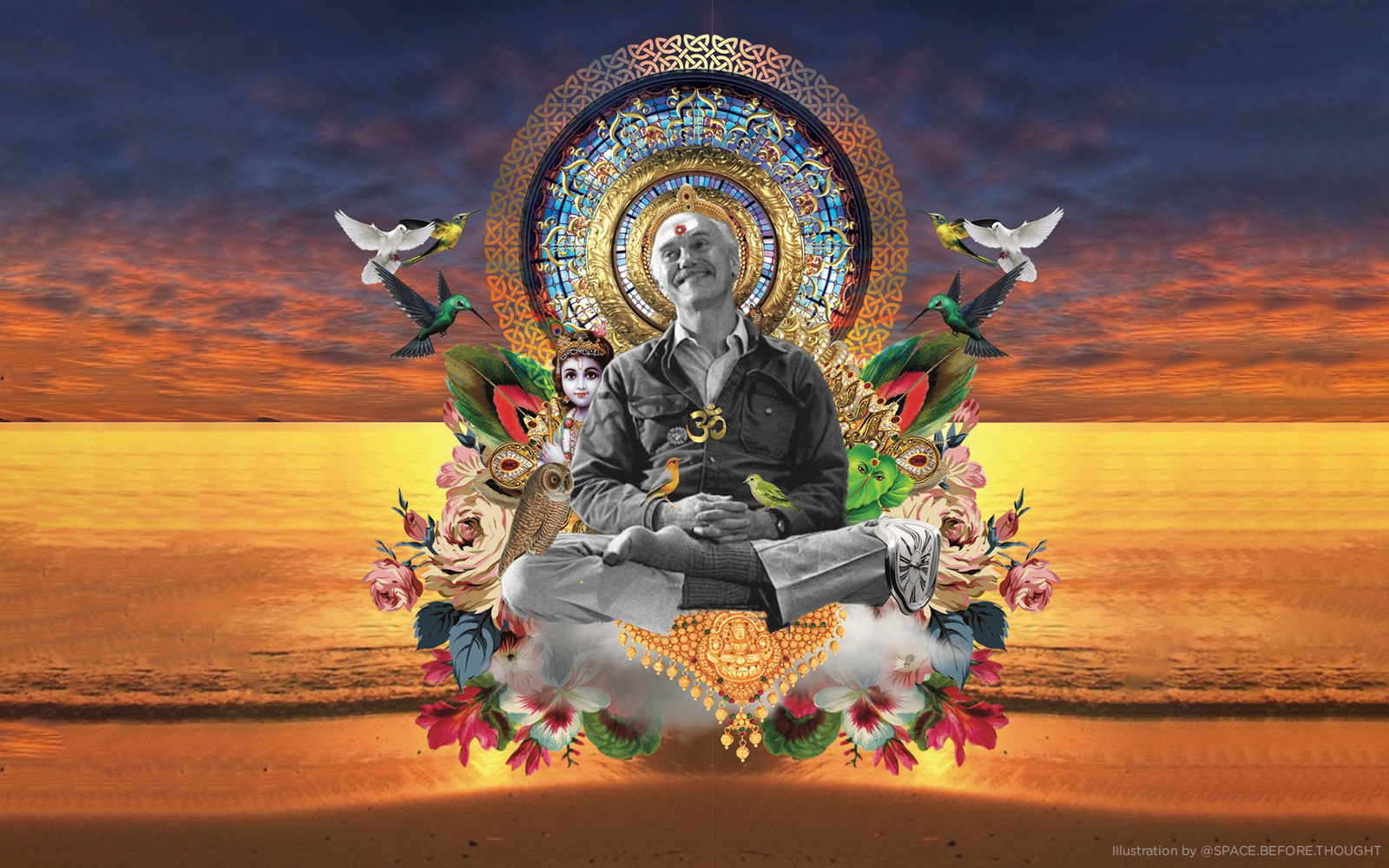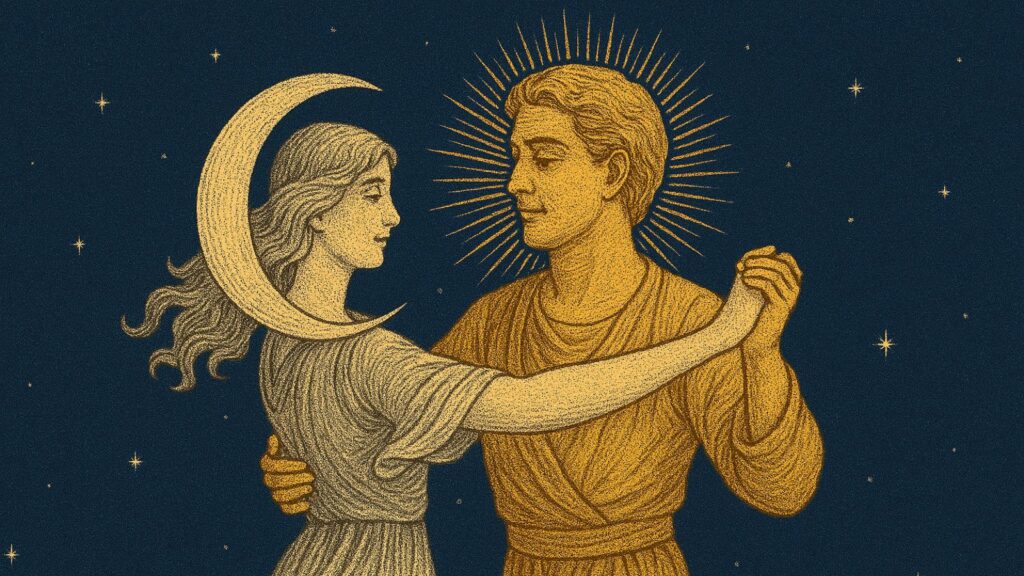Ram Dass and his work with psychedelics ignited the flame that lit the way for his deeper spiritual journey. Mind-altering psychedelics were simply the soundcheck to the main stage show. Dass found the ultimate highs on his mystical explorations into consciousness, or what he refers to as loving awareness. Love awareness may be the most advanced psychedelic out there. I think we all ought to give it a shot.
As souls, we are not under time, or space. We are infinite. When I don’t know who I am, I serve you. When I know who I am, I am you. I am loving awareness. I am home.
—Ram Dass
Who is Ram Dass?
Ram Dass is most popularly known for his best selling book, Be Here Now, which can be found quoted and plastered all over social media pages. Be Here Now spread Eastern spirituality and yoga to the baby boomers of the West. Okay, boomers, thank you for picking up what Dass was laying down.
Dass is one of the most alluring spiritual leaders of the consciousness revolution of the 1960s and ’70s. A Harvard professor and LSD researcher-turned-spiritual leader, he paved a poetic path into the source of consciousness itself.
Family and Education
Ram Dass was born Richard Alpert on April 6, 1931, in Boston, Mass. He grew up in a Jewish family and was the youngest of three brothers. His father, George Alpert, was a prominent lawyer and businessman. Dass realized on the night of his bar mitzvah that he had no interest in religion, until later in his life when he experimented with psychedelics.
Dass earned a bachelor’s degree from Tufts, a master’s from Wesleyan, and a Ph.D. from Stanford, all in psychology. Upon graduating, he followed his mentor, David McClelland, to Harvard. Dass wore many hats at Harvard. He had roles in the psychology and social relations departments, the graduate school of education, and the health service, where he served as a therapist.
“In 1961, at the beginning of March, I was at the high point of my academic career,” he wrote in Be Here Now. “I was making a great income, and I was a collector of possessions,” among them an antiques-filled Cambridge apartment, a Mercedes-Benz, an MG sports car, a Triumph 500cc motorcycle, and a Cessna 172 airplane. “But what it all boils down to is that I was really a very good game player.”
Richard Albert
Life and Loves
Dass didn’t speak much about his love life and sexuality until later in his life. He was involved with men as well as women. His identification was, bisexual, but he wasn’t entirely vocal about it. He beautifully states, “I’ve started to talk more about being bisexual, being involved with men as well as women,’ and added his opinion that being gay isn’t gay, and it’s not not-gay, and it’s not anything—it’s just awareness.
He was sexually intimate with multiple partners in his life but never had a family with any of them. Then, at the ripe age of 78, Dass learned that he had fathered a son as a 24-year-old at Stanford. During a brief intimate relationship with a history major, Karen Saum, they had conceived a child. When Peter Reichard, a 53-year-old banker caught longing suspicion from his mother, he connected with Dass to get a DNA test that in fact came back positive.
Education and Professorship
Harvard
Dass’s professorship at Harvard and his explorations of human consciousness led him to collaborate with other counterculture leaders. These included Timothy Leary, Ralph Metzner, Aldous Huxley, Allen Ginsberg, and others, in the pursuit of psychedelic research. This research produced two books: The Psychedelic Experience, and LSD.
The communal feeling from the psychedelic research cohort was that they had uncovered a scientifically revolutionary wrinkle in human consciousness. With the consent of Harvard, Leary and Dass began giving out—fairly willy-nilly—psilocybin and a questionnaire to basically anyone who was interested.
“At one point,” Dass writes, “I took five people and we locked ourselves in a building for three weeks. We took 400 micrograms of LSD every four hours. That is 2400 micrograms of LSD a day.… We finally were just drinking out of the bottle.… We were very high. What happened in those three weeks in that house, no one would ever believe, including us. And at the end of the three weeks, we walked out of the house and within a few days, we came down! It was a very frustrating experience as if you came into the kingdom of heaven and you saw how it all was … and then you got cast out again.”
It wasn’t long after this experience that Harvard gave their research the boot. The university fired then-Richard Alpert from the faculty for allegedly giving psychedelics to an undergraduate. The undergraduate student apparently was a real James Dean type.
Millbrook
Awestruck by their findings at Harvard, Dass and Leary assembled friends and followers with a shared lust for life. The crew went to Mexico, where they were said to have had a ritual with none other than the mother of mushrooms herself, Maria Sabina. Upon their return to America, they acquired a space to continue to conduct their experiments in Millbrook, New York. Heiress, follower, and friend Peggy Hitchcock generously loaned them her estate.
Dass and Leary immediately set up a core group, including many former colleagues from Harvard. Their journal, the Psychedelic Review, devoted itself to exploring death and rebirth. They learned from The Tibetan Book of the Dead, and sought to cultivate the divinity with each individual. This core group often experimented in group LSD sessions, looking for a permanent route to higher consciousness.
At Millbrook, they experimented with psychedelics and often participated in group LSD sessions, looking for a permanent route to higher consciousness. They hosted weekend retreats on the estate. Guests paid to embark on the psychedelic journey without drugs, through meditation, yoga, and group therapy sessions. These sessions and experiments continued for quite some time, until a government raid shut them down for good.
Servant of God
As far out as that all sounds, the journey of Dass really begins in 1967. At that time, he had hit a wall with psilocybin, LSD, and Leary. He took a pilgrimage eastward, pursuing a great sustainable high from which he would never have to come down.
From Afghanistan to Nepal, Dass spent months on his quest to share LSD and other psychedelic substances from his nomadic medicine kit with monks and holy persons. He was in search of an explanation for the drugs and a clearer path to understanding consciousness. Exhausted and frustrated with unfulfilled longings, Dass finally arrived at the steps of a Hindu sadhu, or wandering saint, in the foothills of the Indian Himalayas. Maharaj-ji Neem Karoli Baba, who lived in the current between form and formlessness, was an enlightened being in the eyes of Dass. Maharaj-ji’s existence was a constant natural flow between his earthly body and the great beyond. Maharaj-ji took Richard Alpert into his ashram and gave him the name Ram Dass. This name translates into “servant of God.”

Spiritual and Religious Pursuits
Dass spent six months in silence—cold bath every morning at 4 a.m., vegetarian diet, extreme meditation and breathwork, and education in bhakti-yoga. He used a piece of chalk and a slate to communicate.
“These medicines will allow you to come and visit Christ, but you can only stay two hours. Then you have to leave again. This is not the true Samadhi. It’s better to become Christ than to visit him—but even the visit of a saint for a moment is useful. But love is the most powerful medicine.”
—Neem Karoli Baba
Resettling in America in 1974, he started a new life based on a different kind of psychedelic research and his own synthesis of Buddhist, Hindu, Advaita, and Sufi teachings, and later, Jewish mysticism.
Later Years
Dass’s years after India until his death were full of devoted service to humanity. He focused on teaching, writing, and working to develop foundations. He launched the Hanuman Foundation to further the teachings of Neem Karoli Baba. In addition, he set up the Prison Ashram Project through Hanuman, offering counseling and spiritual practice to the incarcerated, many of whom had contacted Ram Dass after reading Be Here Now. Dass also set up the Seva Foundation, which works to combat blindness in the Himalayas. He also helped create the Dying Project, which helps teach and practice dying consciously. The Dying Center, located in Santa Fe, New Mexico, was the first residential facility in the U.S. where people could come to die “consciously.”
He traveled internationally, giving talks, hosting retreats, and holding fundraisers for charitable causes in the 1970s, ’80s, and ’90s. In 1997, a stroke hit Ram Dass, leaving him with paralysis and expressive aphasia. Spiritually mature, he quickly acknowledged this as a lesson and an act of grace.
He moved to Maui, Hawaii in the early 2000s where he hosted annual retreats with other spiritual teachers and friends. Dass put his conscious dying teachings to practice in his Maui residence. He honored his body with many hours of assisted swimming, and humbled his existence by receiving the help, support, and unconditional love he needed in his dying years. He died on December 22, 2019, at the age of 88.

Top Ram Dass Quotes
[From BoingBoing’s David Pescovitz} “My life has been a dance between power and love,” he observed after the massive cerebral hemorrhage in 1997 that left the charismatic, preternaturally articulate teacher groping for words. “First part, till Harvard: power, power, power, power. Up until drugs, I thought power was the end all and be all, because I was a little individual. Then drugs: love, love, love, love. My first mushroom trip was so profound that I saw radiance was inside, and I said, ‘I’m home, I’m home, I’m home.’”
“The most important aspect of love is not in giving or the receiving: it’s in the being. When I need love from others, or need to give love to others, I’m caught in an unstable situation. Being in love, rather than giving or taking love, is the only thing that provides stability. Being in love means seeing the Beloved all around me.”
“In our Western culture, although death has come out of the closet, it is still not openly experienced or discussed. Allowing dying to be so intensely present enriches both the preciousness of each moment and our detachment from it.”
“Compassion refers to the arising in the heart of the desire to relieve the suffering of all beings.”
“The most exquisite paradox … as soon as you give it all up, you can have it all. As long as you want power, you can’t have it. The minute you don’t want power, you’ll have more than you ever dreamed possible.”
Ram Dass In Culture
Instagram Famous
If you have explored the spiritual corners of Instagram, it is 100% likely that you have stumbled upon a goose bump-evoking quote with Ram Dass’s name attached to it. For those freshly free-falling into their own spiritual journey, it may seem that Ram Dass didn’t exist at the same time, space, or dimension as the rest of us. It is important for us to humanize Ram Dass beyond his magnetic quotes. With a whopping 666K followers on Instagram, we can continue to integrate and build upon the work Dass left for us.
Here and Now the Podcast
The spiritual teacher also hosted a radio show and a podcast series and continued his teachings online and with retreats in Maui, where he resided. Ram Dass’s podcast is popularly known to kick you in the ass with inspiration and goose bumps. It is highly recommended to dive into it, and there is no better place to start than Here and Now. 😉
Works
Books
Be Here Now was Ram Dass’s first book for the masses, which has sold over 2 million copies since publication in 1971. He offered seekers an engaging, unconventional, slightly zany road map for finding a spiritual path and a more enduring connection to a higher consciousness than a tab of acid could bring.
He authored or co-authored twelve more books on spirituality over the next four decades, including Grist for the Mill; How Can I Help? ; Polishing the Mirror,; and Walking Each Other Home.
Ram Dass’s books can be purchased at https://shop.ramdass.org/.
Films
Netflix has created a wonderful documentary on Dass. From his home on Maui, pioneering researcher, author and spiritual teacher Ram Dass reflects on love, life, and death as his own days draw to a close. The trailer is even more inspiring and evocative.
On RS
Soul Man: Ram Dass on Attachment, Psychedelic Drugs, the ’60s revolution, & more
Be Love Now: A Visit with Ram Dass
Dying to Know: A Talk with Filmmaker Gay Dillingham
RS Contributing Author: Niki Perlberg
Niki is a social and arts entrepreneur who specializes in project and creative production development. With her passion for social structures and the arts, she has been involved in the architecture of performance and festival culture around the country. In rapidly changing times she is now taking her passion for these sub-cultures and sharing them with us in our digital atmosphere through her writing and content development. Some of her favorite parts of life are coffee, campfires, and contemplating the mysteries of existence. Feel free to follow her on Insta @itsnikiperl
Featured Image Credit: IG – @SPACE.BEFORE.THOUGHT
Quote Image Credit: IG – @deannacaroline













